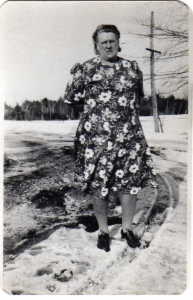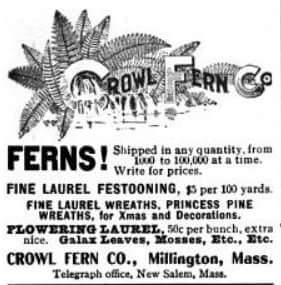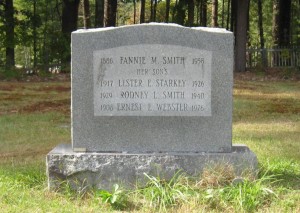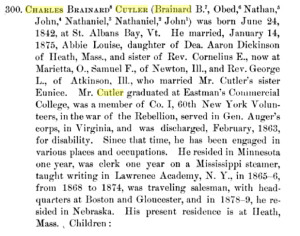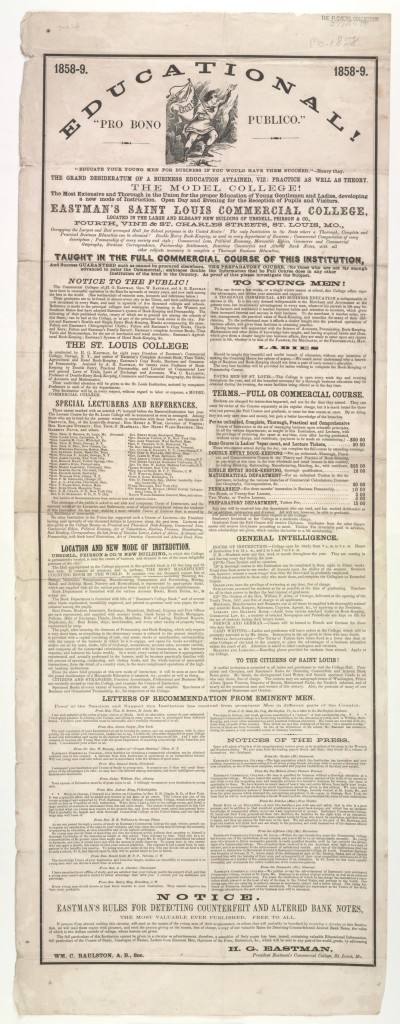Fannie M. Ames/Webster/Starkey(Sharkey)/Smith – owned land along New Salem Rd in 1940s and 50s
LAND TRANSACTIONS
in 1929, Fannie bought 6+ acres including some buildings in Orange (747/363) for $1500
it looks as though Fannie and her then-husband Lester [Leslie?] Smith owned land in southeastern New Salem that was taken for the Quabbin Reservoir in 1928 (756/274)
- deed reads “Fannie M. Smith (formerly Fannie Starkey, sometimes known as Fannie Sharkey)”
- she and her husband [?] seem to have bought two 10-acre parcels land from Myron and Elvie Doubleday in 1925 (704/189) and 1927 (677/237)
- first parcel was on April 1, 1925 – 10 acres in Dana – Myron Doubleday bought this from William L. Newton in May 1920 (662/218); it previously went from someone named Brown to Levi Newton (388/229)
- the second one is more confusing – the deed goes from Lester Smith, unmarried, to Fannie Starkey, for two 10-acre parcels, including one that “is the open or mowing land, and a part of the farm formerly owned by Levi Newton” (so presumably this is the first parcel), and a second contiguous 10-acre parcel – both of these were conveyed to Lester Smith and Fannie Starkey by two deeds on April 1, 1925 (704/188 and 704/189) – so it’s unclear why the later deed registration for the earlier sales
in 1939, Fannie (again, on her own – deed says “umarried”) bought the three parcels of land (100 + 12.5 + 15 acres) on New Salem Road from Ernest E. Webster of Orange (835/288)
- a second deed (835/329) shows that she also sold 19 acres (with buildings) at the intersection of Wheeler Ave and Goddard Ave in Orange to [her son] Ernest E. Webster
- he assumed the back taxes for 1937-1939 with this sale
then in 1961 we have Fannie’s son Ernest E. Webster administering the sale of Fannie’s land after her death
- he sold 197.5 acres on New Salem Rd (the original 127.5 acres plus the 70 acre William Leonard farm that she added in 1941) to Max and Barbara Winchester for $8000.00
PERSONAL
Fannie Ames born in Bridgewater, Mass. on March 24, 1886
- parents were Ephraim Frederick Ames (a stonemason born in Walpole 1854-1921) and Ida May Bisbee (born in East Bridgewater 1864-1921
- Fannie’s father Ephraim Frederic Ames b Nov 23, 1853 in Walpole, Mass. – father Ezekiel is listed as a boot-maker, born in Canton; mother Julia’s birthplace is listed as Bridgewater
- in 1865 state census he was living with his family in Wrentham – his father is listed as a Maine-born farmer
- the bicentennial history of New Salem (pp 69-70) notes that “F. Ames” was living in an old house there in 1871
- Fannie’s mother Ida May Bisbee Ames b June 27, 1864 – parents are Otis Bisbee and Eliza White Ramsdell Bisbee – in the 1870 US census Otis is listed as a stonemason, as is his oldest son Frederic, 19 – the next son John, 17, is listed as a farmer, and the next, Clarence, 14, as a farmhand – the family seems to be quite well-to-do, with property value at the top of their East Bridgewater neighborhood
- Fred and Ida married in East Bridgewater on Nov 13, 1879 when Ephraim was 25 and Ida was 15!
- the 1880 US Census lists Fred E. Ames, 26, and Ida M. Ames, 16, living in West Bridgewater, where he is a laborer
- Fannie was born in 1886, seemingly the first of their children to survive
Fred Ames’ older sister Julia (c.1846-1912) also lived in New Salem for a time – she was married at least twice:
- in the 1870 US Census the whole family is living together in Wrentham:
- Ezekiel Ames 46 farmer
Julia F Ames 42
E Frederic Ames 16
Richard Ames 13
Hattie M Ames 8
William Ames 6
Lizzie Ames 4
Ittilai [?? that’s really what it looks like] Gifford 37 farmer
Julia Gifford 23 – so Julia has married an older man – not clear whether Joseph is their son or his – if theirs, then she has also (like Fred’s wife Ida) married extremely young
Joseph F Gifford 7
Frank Gifford 4
Lena M Gifford 3
Julia I Gifford 1
Levi S Gay 24 moulder
Annette F Gay 19 - there’s no personal property listed for this very extended household!
in the 1880 US Census Fannie’s grandfather Ezekiel [Ezekell] appears to be living in Wendell:
- entry #6 in the ag census
- he’s got 12 acres of tillage, 49 of pasture/open land, 20 acres of woods
- 10 acres mowed, 2 not mowed, made 5 tons of hay with one horse
- value of farm is $700, equipment $50, livestock $108 (all mid-low range)
- value of products sold is $185, mid-upper range
- he owned 3 milk cows and 3 other cows, 5 of which he purchased that year
- the farm made 250 lbs of butter, a very high amt [I think I remember seeing his name in the W.W. Wood ledger]
- also had one pig and 14 chickens – sold 30 dozen eggs
- grew just half an acre of Indian corn, netting 20 bushels
- 1 acre of potatoes –> 100 bushels, a substantial amount
- 25 apple trees for 40 bushels of apples and $20 value
- 8 cords of wood sold for $16
in the 1880 US Census, aunt Julia has remarried to a younger man (m. Feb 11, 1879) and is living with her second family (and the four children from her first) in Walpole:
- Henry J. Smith 24 farm laborer, born in [South Boston] Mass., parents from England
Julia F. Smith 32
Joseph G[ifford?] Smith 17 works in Emory [?] Mill
Frank G[ifford?] Smith 15
Lena G[ifford?] Smith 12
Julia I. Smith 10
Nelly F. Smith 7
at some point Fred and Ida’s family moved to New Salem – here they are in the 1900 US Census:
- Ephraim F Ames 47 stone mason – shows both of his parents were born in Maine, he was born in Mass. – owns his own home
Ida May Ames 36 born in Mass. of Mass.-born parents – has borne 9 children, 5 living – married 20 yrs
Fanny M Ames 14
Florence C Ames 13 (1887-1956) – here’s a photo of her from the Andersen Family Tree on Ancestry
Leon F Ames 10
Julia F Ames 5 (1894-1929)
Eliza W Ames 1
James E Sweetland 52 lodger/basket maker
in the 1900 US Census, aunt Julia is widowed and she and her second family are now living in Deerfield:
- Julia F Smith 52
Frank L Smith 36 farm laborer
Ella F Hatstat 26 servant
Alice M Hatstat 7
Charles B Reynolds 53 boarder
- Mrs. Julia Ames Smith bought a house in New Salem around 1900, and moved there with her son Frank Gifford and daughters Julia Howes and Ella Hatstat – the daughters lived there until 1933 when the MDC bought the property and tore the house down (New Salem bicentennial history, p 73) – Julia (1846-1912) was Fred Ames’ sister, so Fannie’s aunt
- the Augustus Holden house in New Salem was bought by “Fred E. Ames and Mrs. Ames” about 1904 – “About 1912 the Frank M. West Box Company acquired 33 acres of the 40 acre farm. The house and cleared land also was sold to Julia Smith and her heirs.” (p 74)
- a Mr. and Mrs. Ezekiel Ames also owned an old small house on West Street in New Salem (Melvina French, who married Nathan Hudson of Wendell, had earlier lived in the same house) (p 79) – so did Fred and Julia Ames’ parents eventually move to New Salem too?
Florence GERTRUDE Ames Rice Wright Starks (Fannie’s next youngest sister, a year younger)
on March 3, 1902, Fannie married Ernest Edward Webster (1879-1908) in front of a JP in Vernon, VT
- she was 18, he was 22
- he was a sawyer – parents Charles F. Webster (1845-1899) and Laura Gee (1847-1894)
- he had already been married and widowed – strangely, his first wife was also Fannie M.! (Shaw) (1878-1899) – a tremendous amount of loss in this family in a short time
- looks as though Ernest and Fannie (Shaw) had a son, Rodney Earl Webster (1899-1982)
- Fannie (Ames) and Ernest had a daughter (Althea? Laura?) in 1902 and two sons, Forrest (b 1905) and Ernest (b 1908)
- and then father Ernest died 1908, leaving 24-yr-old Fannie with three small children
in the 1910 US Census Fannie is married and living in Buckland with her considerably older husband Fred Starkey and a young family, plus a couple of her siblings and a baby belonging to one of them:
- Fred E Starkey 41
Fanny M Starkey 24
Laura AWebster7 – the Webster children are listed as stepchildren of Fred – they are Fannie’s children from her previous marriage
Forrest LWebster4
Ernest EWebster2
Leon F Ames 20
Julia B Ames 21
Catharine Ames 0 [11/12] – census says “niece” – i.e. a daughter of (presumably) Julia?
meanwhile back in New Salem, here is the Ames household in 1910:
- Ida M Ames 45 married, but no husband in sight – had he left the family? or died?
Eliza W Ames 12
grandson Harold W Rice 6 (probably a child of Gertrude, one of whose husbands was named Rice) - Ida is listed as the head of her household and is working as a laborer for the Crowl Fern Co – this was a company that grew ferns, laurel, etc, run by a family named Vineca and named for the Crowls who started the business before 1890 – the building burned around 1930 and the company closed – see New Salem bicentennial history (1953) pp 99-100 and MHC Reconnaissance Report p 11
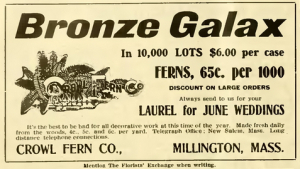
The Florists Exchange, Vol 22, 1906
also in the 1910 US Census are the other Ames/Smith/Hatstat relatives, next door to Ida:
- Julia F. Smith, 63, widowed, born in Mass, father born in Maine, mother in Rhode Island – she has had five children, all living, and she owns the property the family is living on
- Frank Gifford, her son, 44, a farmer (1866- )
- Julia I. Howe, her daughter, 40, working at the fern company (1870- )
- Ella F. Hatstat, her daughter, 31, also working at the fern company (1874- ) – Ella is listed as married for 18 yrs, but there’s no husband in the household – she’s had one child
- Alice M.B. Hatstat, 16, presumably Ella’s child
aunt Julia Ames Smith died Nov 28, 1912 – she’s buried in the North New Salem Cemetery
in the 1920 US Census Fannie is living back in New Salem, still listed as married although there’s no husband in the household (she is head), with the following:
- Fannie Starkey 33 occupation “washwoman” for a private family or families – can’t tell from the handwriting – she’s renting a farm property – next door are Paul and Ella Richardson and their two daughters – he’s the owner of a Box Shop – might this family have been wealthy enough to employ her?
Forrest Webster 14
Ernest Webster 11
Charles Starkey 10
Eugene Starkey 8
Robert Starkey 6
Leslie Starkey 3
Fred E. Starkey is extremely hard to find other than in the 1910 census – in the 1920 census the birthplace of the Starkey children’s father is given as “at sea”!
deeds show that Fannie and her husband Lester Smith bought two 10-acre parcels land from a Myron Doubleday in 1925 (704/189) and 1927 (677/237)
Fannie (Ames) Starkey is listed in the state vital stats as having been married in 1928 – shown in New Salem (36/450) and Warwick (54/258)
sister Julia d. 1929
in the 1930 US Census, Fannie has a third family living at a farm property they own on Wheeler Ave (this is at Goddard Rd and Wheeler Ave – not sure where Goddard Rd is or was, but census records put it somewhere between East Rd and Wheeler Ave, with just four small households showing there in 1940 – I think it’s actually Cross Road, where John Moore’s farm is – here’s the 1937 USGS map detail):
- Leslie A Smith 35 teamster on a farm – born in Michigan of two English Canadian parents
Fanny E [should be A] Smith 44
Rodn[e]y L Smith 0 [11/12] – this is Leslie and Fanny’s son – so a very late baby for her
Earnest D Webster 23 – he’s a truck driver
Charles H Starkey 19 – farmer on a general farm (presumably this one)
Eugene F Starkey 18
Robert L Starkey 17 - they have a radio
not unsurprisingly by this point, Lester/Leslie Smith is as hard to track down as Fred Starkey was
in the 1940 US Census Fannie and Rodney (10) are living on East Road in Wendell, where she’s listed as a farmer and the head of the household
- a boarder, George Rock, 61 (b in NY state) is also living there as a Farm Laborer
- also in 1940, Fannie’s son Robert Starkey, 27, is living on Goddard Rd in Orange (presumably at or near the family’s Wheeler Ave property) with his wife Marjorie N., 22 (Marjorie Nell Fairman, 1917-1960) – he’s working (or rather, not working for the past 15 mos) as a plumber’s helper – he has an 8th grade education
Fannie died 1958 – buried in North New Salem Cemetery
children:
- Althea or Laura Webster (1902-?)
- Forrest Lewis Webster (1905-1977)
- Ernest Elwood Webster (1908-1976)
- Charles Starkey (1910-?)
- Eugene F. Starkey (c.1911)
- Robert L. Starkey (Jan 28, 1913-June 29, 1991)
- Lester E. Starkey (1917-1926)
- Rodney L. Smith (1929-1940)
Fannie’s gravestone in the North New Salem Cemetery

